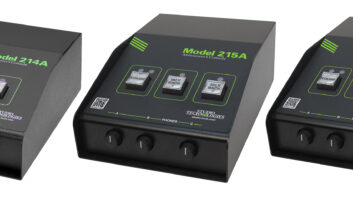Radio World publishes User Reports on products in various equipment classes throughout the year to help potential buyers understand why a colleague made a given equipment choice. These are unpaid testimonials by users who have already purchased the gear. A Radio World Product Evaluation, by contrast, is a freelance article by a paid reviewer who typically receives a demo loaner.

RICHMOND, Calif. ABS-CBN International is a wholly owned U.S. corporate entity of ABS-CBN Broadcasting of the Philippines.
The parent company is the largest media conglomerate in the Philippines operating a television and radio network not unlike ABC, CBS, NBC and Fox here in the U.S. In addition they own and operate cable companies, movie production companies as well as a long-distance and underseas cable telephone services provider.
The International division (that’s us) is tasked primarily with distributing Filipino programming all over the world. We do so using satellite services into North America via DirecTV and Comcast cable; into Europe, the Middle East and Australia via various satellites; and via IPTV into Canada, Japan and islands in the Pacific. In addition, for our secondary task, we provide three transponders (totaling 45 TV channels) of other ethnic programming direct-to-home (DTH) to North America, Hawaii, Alaska and the Caribbean via the Galaxy 19 satellite. These channels include, Thai, Chinese, Laotian, as well as various Middle Eastern channels.
Included in our secondary task is providing telephone and Internet services to Pacific islands, rural telephony to Alaska, data services from the Japanese Ministry of Defense to the Japanese Disaster Relief Team operating in Haiti and data, telephony and Internet services for the U.S. Missile Defense Agency to one of their facilities.
Earth station
Our U. S. satellite earth station teleport is located in Richmond, Calif., near San Francisco. We call our facility the San Francisco International Gateway.
As a satellite earth station teleport, we of course have a need for RF spectrum analyzers. We have several equipment buildings spread out over our two-acre facility, and we have had several older HP and Tektronix analyzers assigned to those buildings to monitor the various services. Unfortunately, we have never commissioned any software to operate and record information from those analyzers remotely. So everything was done manually, including patching RF inputs from one or another antenna or RF transmit chain into an analyzer. We really needed a solution that wasn’t going to cost us a lot of money.
Then along came LP Technologies with their alternative to expensive carrier monitoring software that was currently on the market.
I had heard of LP Technologies and fortuitously was manning our exhibition booth at the Satellite 2009 Exhibition while the LP Technologies booth was two booths away. So I was able to view their products firsthand and I became interested in their LPT-3000R remote rack-mounted spectrum analyzer.
I zeroed in on the LPT-3000R because not only did it offer a user-familiar and user-friendly software interface, but it also covered down to 9 kHz. To us, that meant that we could use this analyzer to view our 70 MHz IF signals, as well as our L-band signals. I remember that another manufacturer’s products didn’t go down to cover 70 MHz, while another’s did but its software interface was not very friendly.
Coupled with the four-input switcher on the front end of the LPT-3000R and the ability to control the analyzers (including the input switch) via Ethernet using the included software, the LPT-3000R was an answer that allowed us to begin making routine remote measurements of our services. Finally, the price per unit was too good to pass up.
We purchased five units through Steve Moreen at the RF Specialties Group San Diego office and located those analyzers throughout our facility. Their delivery was quick as we received them in just one or two weeks after ordering.
We initially found some issues with the included software; however within a short time after mentioning these to LP Technologies, we received updates that included some of our suggestions. They listened to our input and made changes where they could. We later decided to upgrade from the standard software to their LPT-Smart software, which included more useful features and which had been designed around customer recommendations.
Functions
One of the most useful features for a multi-analyzer facility such as ours is to be able to select a memorized remote setup.
The memorized setup will select the correct analyzer IP address, switch to the correct input on that analyzer and then set all of the other analyzer parameters such as center frequency, span, resolution bandwidth and such. This makes it so easy for some of my operators who are not so adept at setting up an analyzer.
The program comes with 21 default memory preset locations, but if you need more, you can create your own preset memory folder, which could hold an unlimited number of presets (depending upon your available hard disk space).
The trace recording and playback is another feature we’ve made use of. You can elect to record subsequent traces as often as once a second for up to 25 hours. (I’m going to suggest to them that they try to increase that time frame.) The recorded trace information is stored in a file on your local desktop or laptop computer.
Users can print, and/or save traces for inclusion in reports to customers and such. There is an alarm function where users can set a high level and/or a low level and the analyzer will issue a notification when either of those set points is reached. It can also send an e-mail notification. The security lockout is useful for preventing “inadvertent” changes to settings.
The analyzer has four markers with Markers 2 through 4 giving delta level and delta frequency readouts continuously, and you can record that marker data to a file on a computer. The analyzer has three traces that can be manipulated. Trace 1 can be set to show an active signal while Trace 2 can be set for Min Hold and Trace 3 set for Max Hold. Or a trace or traces can be frozen so as to compare it to an active trace.
I had mentioned to LP Technologies that we had our own capture and display software that would capture a trace from an HP or Tektronix analyzer via GPIB (General Purpose Interface Bus) and display it in a format that our customers were used to seeing in our reports.
This was a labor-intensive job that required taking a laptop with a USB to GPIB adapter around to each analyzer in each building to capture traces. LP Technologies graciously gave us a copy of their software programming manual so that we could adapt our software to capture our traces from the LPT-3000R via Ethernet. Now I can create reports for my customers without leaving my office. In fact, because of the Ethernet access, I’ve been able to connect to any of my analyzers via my corporate VPN from home and view customer services on my laptop while watching TV in my living room.
Their software still has minor issues that I would like to see changed or corrected; but all in all, I’ve been very happy with the product and with the customer support and response. I fully expect to see some of those changes in future software updates.
S. Edmund Johnson is manager of systems engineering for San Francisco International Gateway, ABS-CBN International.
For information, contact Micky Mukalay at LP Technologies in Kansas at (316) 831-9696 or visitwww.lptech.com.












